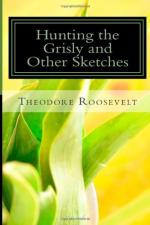Bears will occasionally visit hunters’ or lumberman’s camps, in the absence of the owners, and play sad havoc with all that therein is, devouring everything eatable, especially if sweet, and trampling into a dirty mess whatever they do not eat. The black bear does not average much more than a third the size of the grisly; but, like all its kind, it varies greatly in weight. The largest I myself ever saw weighed was in Maine, and tipped the scale at 346 pounds; but I have a perfectly authentic record of one in Maine that weighed 397, and my friend, Dr. Hart Merriam, tells me that he has seen several in the Adirondacks that when killed weighed about 350.
I have myself shot but one or two black bears, and these were obtained under circumstances of no special interest, as I merely stumbled on them while after other game, and killed them before they had a chance either to run or show fight.
CHAPTER III.—OLD EPHRAIM, THE GRISLY BEAR.
The king of the game beasts of temperate North America, because the most dangerous to the hunter, is the grisly bear; known to the few remaining old-time trappers of the Rockies and the Great Plains, sometimes as “Old Ephraim” and sometimes as “Moccasin Joe”—the last in allusion to his queer, half-human footprints, which look as if made by some mishapen giant, walking in moccasins.
Bear vary greatly in size and color, no less than in temper and habits. Old hunters speak much of them in their endless talks over the camp fires and in the snow-bound winter huts. They insist on many species; not merely the black and the grisly but the brown, the cinnamon, the gray, the silver-tip, and others with names known only in certain localities, such as the range bear, the roach-back, and the smut-face. But, in spite of popular opinion to the contrary, most old hunters are very untrustworthy in dealing with points of natural history. They usually know only so much about any given animal as will enable them to kill it. They study its habits solely with this end in view; and once slain they only examine it to see about its condition and fur. With rare exceptions they are quite incapable of passing judgment upon questions of specific identity or difference. When questioned, they not only advance perfectly impossible theories and facts in support of their views, but they rarely even agree as to the views themselves. One hunter will assert that the true grisly is only found in California, heedless of the fact that the name was first used by Lewis and Clarke as one of the titles they applied to the large bears of the plains country round the Upper Missouri, a quarter of a century before the California grisly was known to fame. Another hunter will call any big brindled bear a grisly no matter where it is found; and he and his companions will dispute by the hour as to whether a bear of large, but not extreme, size is a grisly or a silver-tip.




